BronxArtSpace, Bronx, NY
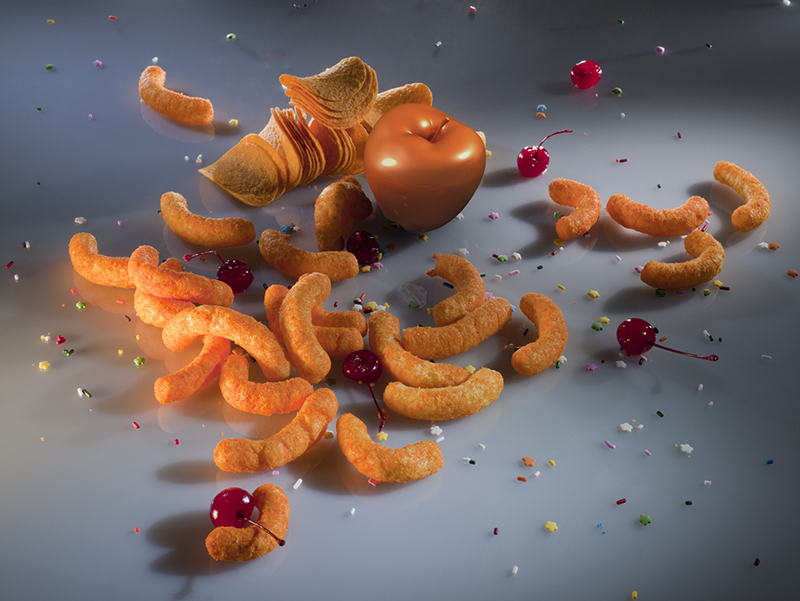
Curated by Rachel Clarke, Claudia Hart, and Pat Reynolds
Saturday November 19-Saturday December 17, 2016
Reception: Saturday, November 19, 4:00 - 7:00
Panel Discussion: Sunday, December 4, 2:00
Real-fake.org.2.0 is an updated and expanded
version of the real-fake.org, an exhibition organized by Rachel Clarke
and Claudia Hart. 2.0 includes the work of 51 post-digital media artists
curated by Rachel Clarke and Claudia Hart now joined by Patrick
Reynolds.
The original exhibition that took place in 2011, with a premiere at the
Cal State Sacramento University Gallery, was accompanied by a website
that defined a new and unusual medium at that time, even for the digital
arts. The exhibition toured the southern US and East Coast and showed
the work of 20 artists that used an array of simulation technologies in
the context of contemporary art, exploring for instance artificial “xyz”
space, the non-referenced, non-indexical synthetic image/object, or the
specific qualities of the virtual camera that records it. The exhibition
showcased regional, national and international artists working
specifically with digital softwares that simulate natural processes -
from physics and biology to analog cinema and photography.
Like the 2011 artists, those in the 2016 exhibition produce still
images, animation, interactivity, sculpture and installation, using 3D
animation as their primary medium. As with their predecessors - the
video artists who adapted TV technologies for artistic uses - these
artists have appropriated the technology employed in the production of
3D shooter games and feature-length Hollywood animation blockbusters,
rejecting or adapting entertainment industry esthetics and content, and
instead applying the medium to the trajectory of art history.
Since the first exhibition, artists who work with simulations have
driven a wedge into contemporary media practice. The 2016 update,
real-fake.org.2.0, features the works of 51 contemporary media artists -
a list that is by no means inclusive. These artists consciously isolate
and define a formal language native to the simulations of the real, a
sub-terrain within an expanding contemporary digital culture, and
integrate those elements into a variety of contemporary artistic
strategies that emerge from the discourses of media and representation,
as they have impacted on photography, experimental film, and
installation-based works.
In 2011 it was rare to find artists involved in contemporary practice
that were deeply invested in exploring the computer graphics of
simulations. Since then, the practice has expanded and grown into a more
broad, contemporary art culture. The languages of these 51 artists
emerge from areas like figurative painting or abstraction, and from
artistic movements ranging from Surrealism, Constructivism and Pop Art,
as well as avant-garde cinema and experimental animation. Since 2011,
“real-fake” computer graphics have finally erased the possibility of
considering photography and film as a mirror of reality, as special
effects have become pervasive in advertising and Hollywood film. The
future of journalism as objective reportage has been threatened by
“reality” television and Fox television, at the forefront in the
branding of pseudo-news-as-entertainment. We also currently live in a
culture of bioengineering where a prosthetic view of the human body
converges the potential of cosmetic surgery with the technological
reality of a science-fiction world in which the artificial has uneasily
crossed a boundary into the real. The boundaries we once perceived
between the physical and the virtual are breaking down as our exposure
to simulation technologies becomes more ubiquitous.
In the face of this paradigm shift, artists respond with an esthetic of
the fake. This is art that crosses the Freudian uncanny divide, at first
creating a sense of disorientation and questioning. Can we trust
anything anymore? We have entered a space of madness, a psychotic space
articulated by a culture that no longer embraces the difference between
a representation and reality. The subjective reality and the objective
merge. Fantasy rules.
Artists in the Exhibition
The real-fake.org.2.0 is an archive as an exhibition. The
works of 51 artists have been collected on a series of reels. The
real-fake.org website has also been expanded and updated. In addition to
the original essays defining real-fake practice written by Claudia Hart
and Rachel Clarke, are new essays by Rachel Clarke, Patrick Lichty and
Patrick Reynolds expanding the language used to talk about simulations
art with technologies that have exploded since the original exhibition,
including printed sculpture and augmented and virtual realities.
Artists:
AES + F, Morehshin Allahyari, LaTurbo Avedon, Sophie Kahn with Lisa
Parra, Gregory Bennett, Tim Berresheim, Sean Capone, Jose Carlos Casado,
Rachel Clarke, Shamus Clisset, Birch Cooper, Gero Doll, Mark Dorf,
Carolyn Frischling, Joe Hamilton, Claudia Hart, Kurt Hentschlager, Kim
Joon, Mark Klink, Alex Lee, Patrick Lichty, Locurto-Outcault, Kristin
Lucas, Sara Ludy, Gerhard Mantz, Chris Manzione, Claudia Mate, Alex
McLeod, Shane Mecklenburger, Rosa Menkman, Jonathan Monaghan, Brenna
Murphy, Eva Papamargariti, Will Pappenheimer, Sabrina Ratte, Michael
Rees, Pat Reynolds, Benjamin Rosenthal, Nicole Ruggiero, William
Robertson + Alfredo Salazar-Caro, Martin Sampedro, Ellen Sandor, Rick
Silva, Keith Tolch, Katie Torn, Matthew Weinstein, Ryan Whittier-Hale,
Frank Yefeng Wang, Snow Yunxue Fu, Giselle Zatonyl, and Zeitguised.
-Text by Claudia Hart and Rachel Clarke, 2011-2016
Real-fake.org.2.0; exhibition installation, BronxArtSpace, November 19 - December 16, 2016. Works, left to right, by: Mark Klink, Sean Capone, Sara Ludy; photo by Gregory Bennett.
Real-fake.org.2.0; exhibition installation, BronxArtSpace, November 19 - December 16, 2016. Work by Gerhard Mantz; photo by Gregory Bennett.
Real-fake.org.2.0; exhibition installation, BronxArtSpace, November 19 - December 16, 2016. Works, left to right, by: Rosa Menkman, Shamus Clisset, Gregory Bennett; photo by Gregory Bennett.
Real-fake.org.2.0; exhibition installation, BronxArtSpace, November 19 - December 16, 2016. Works, left to right, by: Will Pappenheimer, Gregory Bennett, Kristin Lucas; photo by Gregory Bennett.
Alan Warburton
Spectacle, Speculation, Spam, 2017
"A presentation I made for the Edge of Frame Weekend seminar at The Whitechapel gallery in East London, December 2016. Artists, curators and academics were asked to explore where experimental animation practice sits in relation to independent animation, visual art, histories and institutions. Rather than presenting papers, we were challenged to cite up to three works that illustrated our case."
- Alan Warburton
University Galleries, Wayne, NJ
The Real Fake (and Really Fake)Curated by Rachel Clarke, Claudia Hart and Michael Rees
University Galleries, William Paterson University, Wayne, NJ
Monday October 24-Friday December 2, 2011
Reception: Thursday, November 3, 4:30 - 6:00
Panel Discussion: Thursday, 11/17, 12:30
Artists
Kari Altmann (Baltimore), Jose Carlos Casado (NY), Rachel Clarke (Sacramento), Claudia Hart (Chicago), Spencer Hutchinson (Chicago), Yael Kanarek (NY), Brian Khek (Chicago), Alex Lee (Seoul), Lenox-Lenox (Chicago), Alex McLeod (Tornonto), Jon Rafman (Montreal), Michael Rees (Montclair), Lou Regele (Chicago), Timur Si-Qin (Berlin), Yemenwed (NY), Katrina Zimmerman (Chicago), Zeitguised (Berlin)
Really Fake, a virtual public art project curated by Chris Manzione, ran concurrently with The Real-Fake on the grounds of William Paterson University
University Library Gallery, Sacramento, CA
Curated by Rachel Clarke and Claudia Hartwith special thanks to Michael Rees
University Library Gallery, California State University, Sacramento, CA
Friday April 1-Saturday May 28, 2011
Reception: Wednesday, April 6, 5:00pm-8:00pm
Artists
Kari Altmann (Baltimore), Sheldon Brown (San Diego), Jose Carlos Casado (NY), Rachel Clarke (Sacramento), Claudia Hart (Chicago), Spencer Hutchinson (Chicago), Yael Kanarek (NY), Brian Khek (Chicago), Alex Lee (Seoul), Lenox-Lenox (Chicago), Alex McLeod (Tornonto), Open Ended Group (NY), Jon Rafman (Montreal), Michael Rees (Montclair), Lou Regele (Chicago), Timur Si-Qin (Berlin), Yemenwed (NY), Katrina Zimmerman (Chicago), Zeitguised (Berlin)
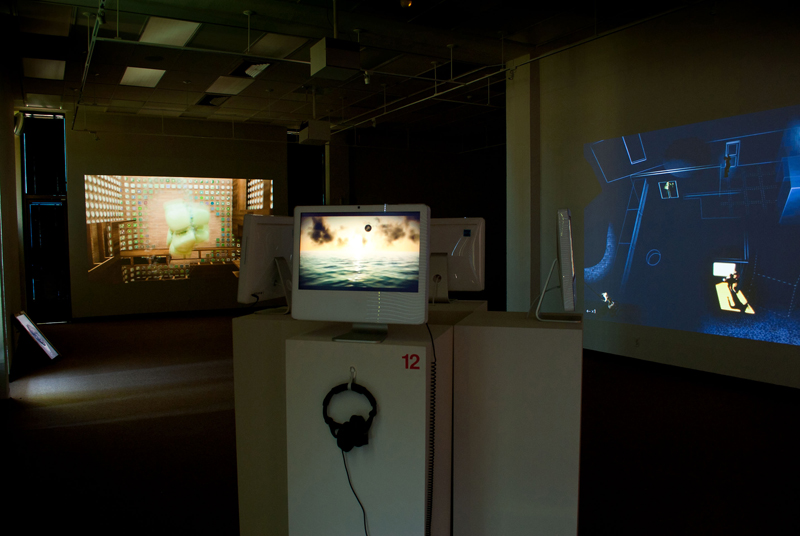
The Real and the Fake; exhibition installation, University Library Gallery, CSUS, April 1 - May 28, 2011. Works, left to right, by: Zeitguised, Alex Lee, Open Ended Group; photo by Sam Parsons.
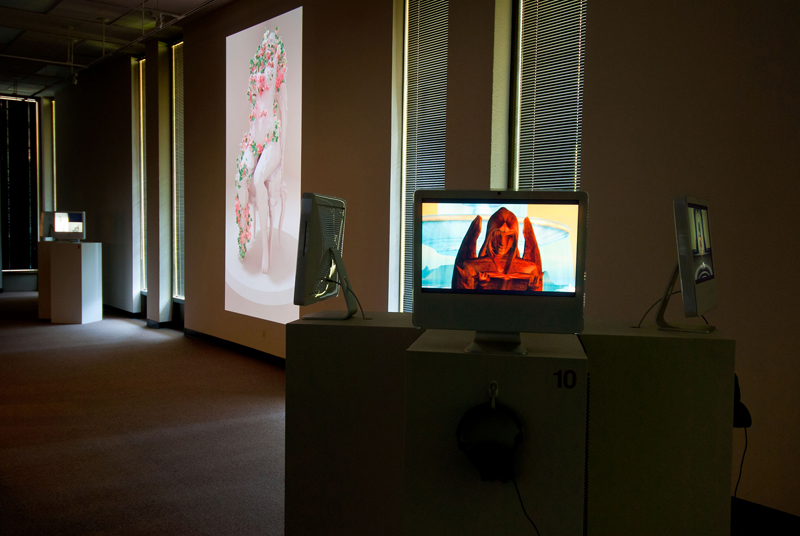
The Real and the Fake; exhibition installation, University Library Gallery, CSUS, April 1 - May 28, 2011. Works, left to right, by: Claudia Hart, Jon Rafman; photo by Sam Parsons.
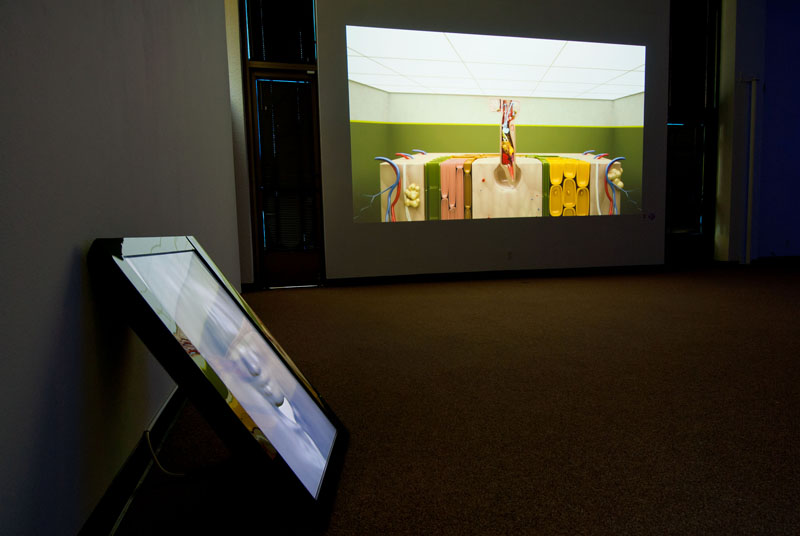
The Real and the Fake; exhibition installation, University Library Gallery, CSUS, April 1 - May 28, 2011. Works, left to right, by:Timur Si-Qin, Zeitguised; photo by Sam Parsons.
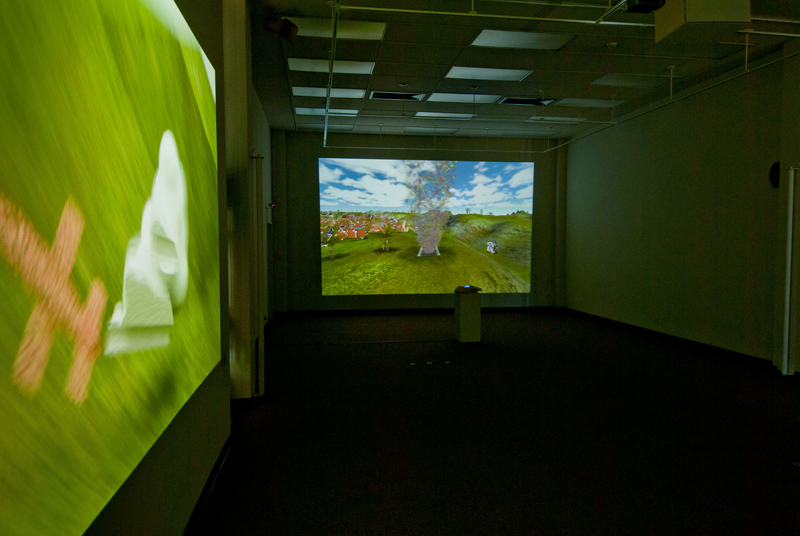
The Real and the Fake; exhibition installation, University Library Gallery, CSUS, April 1 - May 28, 2011. Works, left to right, by: Zeitguised, Sheldon Brown; photo by Sam Parsons.























